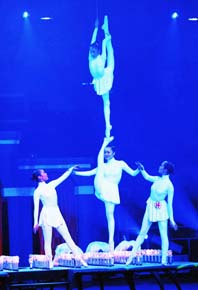 Chinese acrobatics boasts a long history. The practice of early acrobatics dates back to the Neolithic Age. It was during the Qin Dynasty (221-206 B.C.) though that acrobatics made their debut as a performing art. By the Eastern Han Dynasty (25-220), various performing arts, known as the Hundred Plays, were established with acrobatics as the focus.
Chinese acrobatics boasts a long history. The practice of early acrobatics dates back to the Neolithic Age. It was during the Qin Dynasty (221-206 B.C.) though that acrobatics made their debut as a performing art. By the Eastern Han Dynasty (25-220), various performing arts, known as the Hundred Plays, were established with acrobatics as the focus.
Thanks to the royal court's efforts in establishing training facilities for acrobats, the Tang Dynasty (618-907) witnessed the zenith of Chinese acrobatics. It was during the Song Dynasty (960-1279) though that acrobatics became popular entertainment rather than a court-only art. Having given birth to generations of acrobats, some places like Wuqiao in Hebei Province and Yancheng in Jiangsu Province have enjoyed the reputation of being the home of acrobatics.
Excellent in both content and skill, Chinese acrobatics have won prizes at many international competitions. Although they appear to be dangerous, Chinese acrobatics are in fact quite safe. Although the acrobatics look extremely simple, the performers always manage to surprise audiences with breathtaking feats. Traditional Chinese magicians, for example, have amazed audiences by making things like food and pans of flaming fire appear, in a blink of an eye, from under their clothes or a piece of fabric. Chinese acrobatics put emphasis on an acrobat's ability to prop weight on his or her waist and legs, and feature a perfect combination of force and agility. A single performer can support several others all at once, while they perform acrobatic movements. Tools and articles of daily use such as poles, umbrellas, hats, ropes, jars, and bowls are also often used in the performances.
In recent years, China has attached great importance to the entertainment value of acrobatics without losing the essential traditional elements of the art. Thanks to the concerted effort of improving the programs, costumes, stage props, lights, and music, today's acrobatics are not only breathtaking, but enjoyable.
(China Pictorial February 8, 2003)
|

